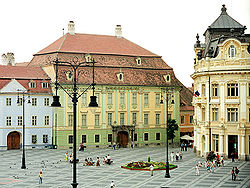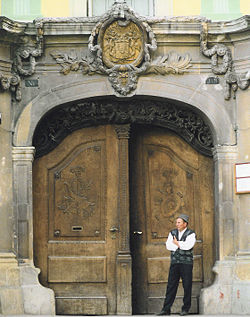
Brukenthal National Museum
Encyclopedia

Museum
A museum is an institution that cares for a collection of artifacts and other objects of scientific, artistic, cultural, or historical importance and makes them available for public viewing through exhibits that may be permanent or temporary. Most large museums are located in major cities...
, erected in the late of 15th century in Sibiu
Sibiu
Sibiu is a city in Transylvania, Romania with a population of 154,548. Located some 282 km north-west of Bucharest, the city straddles the Cibin River, a tributary of the river Olt...
, Romania
Romania
Romania is a country located at the crossroads of Central and Southeastern Europe, on the Lower Danube, within and outside the Carpathian arch, bordering on the Black Sea...
, housed in the palace of Samuel von Brukenthal
Samuel von Brukenthal
Samuel von Brukenthal was the Habsburg governor of the Grand Principality of Transylvania between July 6, 1774 and January 9, 1787...
— who was Habsburg
Habsburg Monarchy
The Habsburg Monarchy covered the territories ruled by the junior Austrian branch of the House of Habsburg , and then by the successor House of Habsburg-Lorraine , between 1526 and 1867/1918. The Imperial capital was Vienna, except from 1583 to 1611, when it was moved to Prague...
governor of Transylvania
Transylvania
Transylvania is a historical region in the central part of Romania. Bounded on the east and south by the Carpathian mountain range, historical Transylvania extended in the west to the Apuseni Mountains; however, the term sometimes encompasses not only Transylvania proper, but also the historical...
and who established its first collections around 1790. The collections were officially opened to the public in 1817, making it the oldest institution of its kind in Romania.
It is a complex of six museums, which, without being separate administrative entities, are situated in different locations around the city and have their own distinct cultural programmes.
The Art Galleries are located inside the Brukenthal Palace and include a number of about 1,200 works belonging to the main European schools of painting, from the 15th to the 18th century: Flemish-Dutch
Dutch and Flemish Renaissance painting
Dutch and Flemish Renaissance painting represents the 16th century response to Italian Renaissance art in the Low Countries. These artists, who span from the Antwerp Mannerists and Hieronymus Bosch at the start of the century to the late Northern Mannerists such as Hendrik Goltzius and Joachim...
, German and Austrian
Holy Roman Empire
The Holy Roman Empire was a realm that existed from 962 to 1806 in Central Europe.It was ruled by the Holy Roman Emperor. Its character changed during the Middle Ages and the Early Modern period, when the power of the emperor gradually weakened in favour of the princes...
, Italian
Italian Renaissance
The Italian Renaissance began the opening phase of the Renaissance, a period of great cultural change and achievement in Europe that spanned the period from the end of the 13th century to about 1600, marking the transition between Medieval and Early Modern Europe...
, Spanish
Spanish art
Spanish art is the visual art of Spain, and that of Spanish artists worldwide. Whilst an important contributor to Western art and producing many famous and influential artists Spanish art has often had distinctive characteristics and been assessed...
and French Schools
French art
French art consists of the visual and plastic arts originating from the geographical area of France...
. The Galleries also include collections of engraving
Engraving
Engraving is the practice of incising a design on to a hard, usually flat surface, by cutting grooves into it. The result may be a decorated object in itself, as when silver, gold, steel, or glass are engraved, or may provide an intaglio printing plate, of copper or another metal, for printing...
s, books, numismatics
Numismatics
Numismatics is the study or collection of currency, including coins, tokens, paper money, and related objects. While numismatists are often characterized as students or collectors of coins, the discipline also includes the broader study of money and other payment media used to resolve debts and the...
, and minerals.
The Brukenthal Library is also located inside the Brukenthal Palace. At the moment it comprises almost 300,000 library units (manuscripts, incunables, rare foreign books, old Romanian-language books, contemporary books and specialised magazines).
The Museum of History is part of a building which is considered to be the most important ensemble of non-religious Gothic architecture
Gothic architecture
Gothic architecture is a style of architecture that flourished during the high and late medieval period. It evolved from Romanesque architecture and was succeeded by Renaissance architecture....
in Transylvania. The museum initially focused its activities on representing the historic characteristics of Sibiu and its surroundings, but in time it has come to reflect the entire area of Southern Transylvania.

Pharmacology
Pharmacology is the branch of medicine and biology concerned with the study of drug action. More specifically, it is the study of the interactions that occur between a living organism and chemicals that affect normal or abnormal biochemical function...
is located in an historical building dated 1569, where one of the oldest pharmacies
Pharmacy
Pharmacy is the health profession that links the health sciences with the chemical sciences and it is charged with ensuring the safe and effective use of pharmaceutical drugs...
in present-day Romania was located.It is the basement of this house where Samuel Hahnemann
Samuel Hahnemann
Christian Friedrich Samuel Hahnemann was a German physician, known for creating an alternative form of medicine called homeopathy.- Early life :Christian Friedrich Samuel Hahnemann was born in Meissen, Saxony near Dresden...
invented homeopathy
Homeopathy
Homeopathy is a form of alternative medicine in which practitioners claim to treat patients using highly diluted preparations that are believed to cause healthy people to exhibit symptoms that are similar to those exhibited by the patient...
and developed his version of treatment. Some of his phials and plans are on display. The furniture is in Viennese
Vienna
Vienna is the capital and largest city of the Republic of Austria and one of the nine states of Austria. Vienna is Austria's primary city, with a population of about 1.723 million , and is by far the largest city in Austria, as well as its cultural, economic, and political centre...
style. The exhibition is organized on the structure of a classical pharmacy that includes two laboratories, a homeopathic sector and a documentation sector. It contains over 6,000 ancient medical instruments and dispensing tools from the time when Sibiu was home to more chemists
Chemistry
Chemistry is the science of matter, especially its chemical reactions, but also its composition, structure and properties. Chemistry is concerned with atoms and their interactions with other atoms, and particularly with the properties of chemical bonds....
than anywhere else in Transylvania. At the front, a reconstructed shop is decked out with wooden counters and stacks of glass jars creating the atmosphere of an 18th century apothecary
Apothecary
Apothecary is a historical name for a medical professional who formulates and dispenses materia medica to physicians, surgeons and patients — a role now served by a pharmacist and some caregivers....
. A valuable collection of wooden pharmaceutical jars, marked with paint, is also featured.
The Museum of Natural History began to take shape in 1849, through the foundation of the Transylvanian Society of Natural Sciences , which had as members important local and foreign figures in science and culture. The collections of the museum comprise over 1 million exhibits (including mineralogy
Mineralogy
Mineralogy is the study of chemistry, crystal structure, and physical properties of minerals. Specific studies within mineralogy include the processes of mineral origin and formation, classification of minerals, their geographical distribution, as well as their utilization.-History:Early writing...
-petrography
Petrography
Petrography is a branch of petrology that focuses on detailed descriptions of rocks. Someone who studies petrography is called a petrographer. The mineral content and the textural relationships within the rock are described in detail. Petrographic descriptions start with the field notes at the...
, palaeontology, botany
Botany
Botany, plant science, or plant biology is a branch of biology that involves the scientific study of plant life. Traditionally, botany also included the study of fungi, algae and viruses...
, entomology
Entomology
Entomology is the scientific study of insects, a branch of arthropodology...
, malacology
Malacology
Malacology is the branch of invertebrate zoology which deals with the study of the Mollusca , the second-largest phylum of animals in terms of described species after the arthropods. Mollusks include snails and slugs, clams, octopus and squid, and numerous other kinds, many of which have shells...
, the zoology
Zoology
Zoology |zoölogy]]), is the branch of biology that relates to the animal kingdom, including the structure, embryology, evolution, classification, habits, and distribution of all animals, both living and extinct...
of the vertebrates, amphibians, reptiles, as well as ichthyology
Ichthyology
Ichthyology is the branch of zoology devoted to the study of fish. This includes skeletal fish , cartilaginous fish , and jawless fish...
, ornithology
Ornithology
Ornithology is a branch of zoology that concerns the study of birds. Several aspects of ornithology differ from related disciplines, due partly to the high visibility and the aesthetic appeal of birds...
, and the zoology of mammals).
The Museum of Arms and Hunting Trophies reflects the evolution in time of weapons and hunting tools. Important is as well the collection of trophies belonging to the collections Witting and A. Spiess, the last one comprising 1,058 items acquired in 1963. Opened for the public in 1966 in Spiess House, the exhibition contains now over 1,500 units. Some traditional hunting procedures are also exhibited, including contemporary engravings. Aspects of the animal life and suitable times for hunting them are also presented here.

